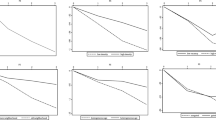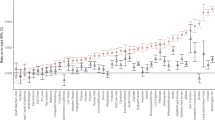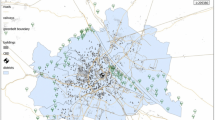Abstract
This paper evaluates how consumers value differences in neighborhood composition and street layout, factors not previously included in empirical studies of house value. Highly connected street patterns are important to New Urbanism. We use measures of neighborhood street connectivity and their interaction with other neighborhood attributes to evaluate how street layout affects property values. We employ two different methods of indexing street layout. Both methods show layout has a significant impact on price, but conclusions are sensitive to the method used. In pedestrian oriented neighborhoods, a more gridiron-like street pattern increases house value using one measure, but greater connectivity decreases house value using the other. In auto-oriented developments, a more gridiron-like street pattern reduces house value using either measure.






Similar content being viewed by others
Notes
These examples are derived using Axwoman 3.0 software (Jiang 1999). This software is used to calculate the Integration variable in the empirical models.
Complete estimates are available from the authors upon request.
References
Asabere, P. K. (1990). The value of a neighborhood street with reference to the cul-de-sac. Journal of Real Estate Finance and Economics, 3, 185–193.
Bafna, S. (2003). Space syntax: A brief introduction to its logic and analytical techniques. Environment and Behavior 35, 17–29.
Batalhone, S., Nogueira, J., & Mueller, B. (2002). Economics of air pollution: Hedonic model and smell consequences of sewage treatment plants in urban areas. Brasilia: University of Brasilia.
Batemen, I., Day, B., Lake, I., & Lovett, A. (2001). The effect of road traffic on residential property values: A literature review and hedonic pricing study. Edinburgh: Scottish Executive and The Stationary Office.
Brain, D. (2005). From good neighborhoods to sustainable cities: Social science and the social agenda of the New Urbanism. International Regional Science Review, 28, 217–238.
Cao, T. V., & Cory, D. C. (1981). Mixed land uses, land use externalities, and residential property values: A reevaluation. Annuals of Regional Science, 16, 1–24.
Clark, D. E., & Herrin, W. E. (2000). The impact of public school attributes on home sale prices in California. Growth and Change, 31, 385–407.
Colwell, P., Gurijral, S., & Coley, A. C. (1985). The impact of a shopping center on the values of surrounding properties. Real Estate Issues, 10, 35–39.
Crafts, J. M., MAI, & SRA. (1998). Impact of commercial development on adjacent residential properties. Appraisal Journal, 65, 6–11.
Crecine, J. P., Davis, O. A., & Jackson, J. E. (1967). Urban property markets: Some empirical results and their implications for municipal zoning. Journal of Law and Economics, 10, 79–99.
Cummings, P., & Landis, J. (1993). Relationships between affordable housing developments and neighboring property values. Berkeley: University of California at Berkeley.
Duany, A., Plater-Zybek, E., & Speck, J. (2000). Suburban nation: The rise of sprawl and the decline of the American dream. New York: West Point Press.
Franklin, J. P., & Waddell, P. (2003). In a hedonic regression of home prices in King County, Washington, using activity-specific accessibility measures (pp. 16). Paper presented at the TRB 2003 Annual Meeting, Washington, DC. (July 31, 2002).
Frew, F., & Judd, G. D. (2003). Estimating the value of apartment buildings. Journal of Real Estate Research, 23, 77–86.
Garreau, J. (1991). Edge cities: Life on the new frontier. New York: Doubleday.
Grether, D. M., & Mieszkowski, P. (1980). The effects of nonresidential land uses on the prices of adjacent housing: Some estimates of proximity effects. Journal of Urban Economics, 8, 1–15.
Hillier, B. (1996). Space is the machine. Cambridge: Cambridge University Press.
Hillier, B. (1999). The hidden geometry of deformed grids: Or, why space syntax works, when it looks as though it shouldn’t. Environment and Planning B: Planning and Design, 26, 169–191.
Hughes, W. T., & Sirmans, C. F. (1992). Traffic externalities and single family house prices. Journal of Regional Science, 32, 487–500.
Jiang, B. (1999). SimPed: Simulating pedestrian flows in a virtual urban environment. Journal of Geographic Information Systems and Decision Analysis, 3, 21–30.
Jo, S.-K. (1996). A balance between pedestrian and vehicular movement in relation to street configuration. Unpublished Doctoral Dissertation, Georgia Institute of Technology, Atlanta.
Kahn, S. A., & Case, F. E. (1977). Real estate appraisal and investment (2nd ed.). New York: Ronald Press.
Kain, J. F., & Quigley, J. M. (1970). Measuring the value of housing quality. Journal of the American Statistical Association, 65, 532–548.
Lake, I. R., Lovett, A. A., Bateman, I. J., & Langford, I. H. (1998). Modeling environmental influences on property prices in an urban environment. Computers, Environment and Urban Systems, 22, 121–136.
Lake Washington School District #414: Elementary School Boundary Map. Retrieved August 10, 2004, from http://www.lkwash.wednet.edu/lwsd/images/schools/BoundariesEL.gif.
Li, M. M., & Brown, J. (1980). Micro-neighborhood externalities and hedonic housing prices. Land Economics, 56, 125–141.
Mahan, B. L., Polasky, S., & Adams, R. M. (2000). Valuing urban wetlands: A property price approach. Land Economics, 76, 100–113.
Maser, S. M., Riker, W. H., & Rosett, R. N. (1977). The effects of zoning and externalities on the price of land: An empirical analysis of Monroe County, New York. The Journal of Law and Economics, 20, 111–132.
McMillen, D. P., & McDonald, J. F. (1989). Selectivity bias in urban land value functions. Land Economics, 65, 341–351.
McMillen, D. P., & McDonald, J. F. (1991). Urban land value functions with endogenous zoning. Journal of Urban Economics, 29, 14–27.
Neighborhood Attendance Reference Areas. Retrieved September 12, 2004, from http://www.seattleschools.org/area/facilities-plan/geo/refarea/ref_area.xml.
Penn, A. (2003). Space syntax and spatial cognition or why the axial line?. Environment and Behavior, 35, 30–65.
Peponis, J., Ross, C., Rashid, M., & Kim, S. H. (1996). Regularity and change in urban space: A syntactic analysis of movement and co-presence in Atlanta. Ekistics, 63, 4–17.
Rotti, C. (2004). Space syntax: Some inconsistencies. Environment and Planning B, Planning and Design, 31, 487–499.
School Guide. Retrieved September 12, 2004, from http://schoolguide.seattletimes.nwsource.com/.
Sirmans, C. F., Turnbull, G. K., & Dombrow, J. (1997). Residential development, risk, and land prices. Journal of Regional Science, 37, 613–628.
Song, Y. (2005). Smart growth and urban development pattern: A comparative study. International Regional Science Review, 28, 239–265.
Song, Y., & Knapp, G.-J. (2004). Measuring the effects of mixed land uses on housing values. Regional Science and Urban Economics, 34, 663–680.
Tu, C. C., & Eppli, M. J. (1999). Valuing new urbanism: The case of the Kentlands. Real Estate Economics, 27, 425–451.
Unlu, A., Ozener, O.O., Ozden, T., & Edgu, E. (2001). In J. Peponis, J. Wineman, & S. Bofna (Eds.), An evaluation of social interactive spaces in a university building. Paper presented at the Space Syntax 3rd International Symposium, Georgia Institute of Technology, Atlanta, Georgia. A. Alfred Taubman College of Architecture and Urban Planning, University of Michigan.
Victoria Transport Policy Institute. (2005). Roadway connectivity: Creating more connected roadway and pathway networks. Retrieved March 3, 2006, from the TDM Encyclopedia, http://www.vtpi.org/tdm/tdm116.htm.
Wallace, N. E. (1986). The market effects of zoning undeveloped land: Does zoning follow the market?. Journal of Urban Economics, 23, 307–326.
Wilhelmsson, M. (2000). The impact of traffic noise on the values of single-family houses. Journal of Environmental Planning & Management, 43, 799–815.
Yi-Luen, D. E., & Gross, M. D. (1997). Tools for visual and spatial analysis of CAD models. In R. Junge (Ed.), Computer assisted architectural design futures. Dordrect: Kluwer Academic Publishers.
Acknowledgement
The authors thank Richard Dagenhart for introducing us to space syntax and an anonymous reviewer for the helpful suggestions. The usual disclaimer applies.
Author information
Authors and Affiliations
Corresponding author
Rights and permissions
About this article
Cite this article
Matthews, J.W., Turnbull, G.K. Neighborhood Street Layout and Property Value: The Interaction of Accessibility and Land Use Mix. J Real Estate Finan Econ 35, 111–141 (2007). https://doi.org/10.1007/s11146-007-9035-9
Received:
Accepted:
Published:
Issue Date:
DOI: https://doi.org/10.1007/s11146-007-9035-9




